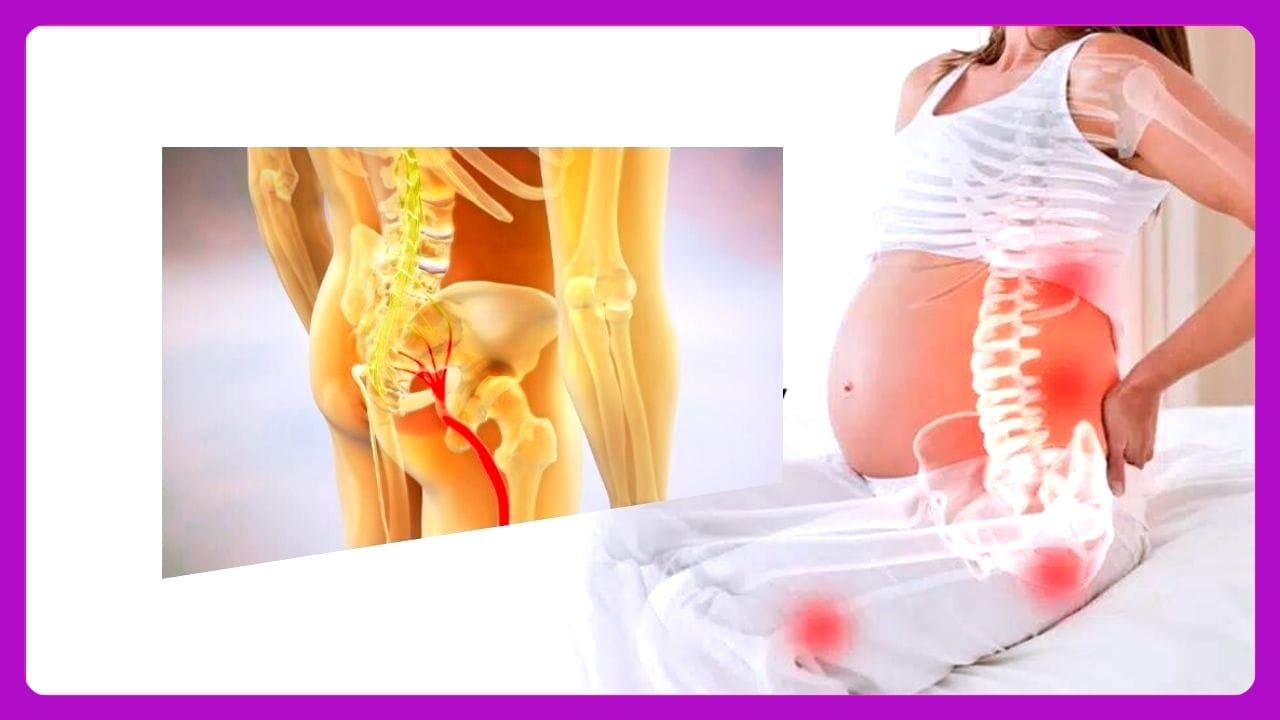Sciatica During Pregnancy: Relief Tips, & Treatment
Experiencing sciatica during pregnancy? Learn what causes it, how to relieve pain safely, and the best treatments to stay comfortable and active.

Pregnancy is a time of significant change, and for some women, this includes the onset of sciatica. Sciatica during pregnancy can cause discomfort and pain, making it a condition that requires understanding and management.
This article aims to provide comprehensive information on sciatica in the context of pregnancy, offering insights into its causes, symptoms, and potential treatments.
In this article, we'll be revealing the myth:
- About sciatica and its relation to pregnancy.
- How to differentiate pregnancy-related pains from Sciatica.
- Practical tips and treatments to manage sciatica during pregnancy.
Sciatica & Pregnancy
Sciatica refers to pain that radiates along the path of the sciatic nerve, which extends from the lower back through the hips and buttocks and down each leg. Typically, sciatica affects only one side of the body.
During pregnancy, hormonal changes, along with the weight and position of the growing fetus, can put pressure on the sciatic nerve, leading to symptoms of sciatica.
The increased levels of the hormone relaxin during pregnancy cause the ligaments in the pelvis to relax and stretch in preparation for childbirth.
While this is a necessary adjustment for the body, it can sometimes lead to instability in the pelvis, which may contribute to sciatica pain.
Symptoms
The hallmark symptom of sciatica is a sharp, shooting pain or a constant burning sensation that starts in the lower back or buttock and travels down the back of the thigh and leg.
Some women may also experience numbness, tingling, or muscle weakness in the affected leg or foot. It's important to differentiate sciatica from other types of pregnancy-related back pain, such as round ligament pain, which is a common and less severe condition.
Unlike general back pain, sciatica will often have a distinct pathway and can be exacerbated by certain positions or movements, such as sitting for long periods or quickly standing up.
The pain can vary in intensity and may be aggravated by specific actions, making it a particularly disruptive condition for expectant mothers.
Sciatica During Pregnancy
Sciatica during pregnancy is a result of the growing uterus putting pressure on the sciatic nerve, which is the largest nerve in the body. This nerve runs from the lower back, through the hips and buttocks, and down each leg.

As the baby grows, the expanding uterus can compress the sciatic nerve, leading to pain, tingling, and discomfort.
Pain in the Lower Back and Buttocks
Expectant mothers may experience sharp, shooting pain that originates in the lower back and travels down one or both legs. This discomfort can range from mild to severe and may be exacerbated by certain movements.
Tingling or Numbness
Sciatica can cause a tingling sensation or numbness in the affected leg. This sensation is often described as pins and needles and may be more pronounced during periods of prolonged sitting or standing.
Burning Sensation
Some women with sciatica during pregnancy may experience a burning sensation near the sciatic nerve. This sensation can vary in intensity and may be accompanied by muscle weakness.
Radiating Pain
The pain associated with sciatica in pregnancy typically radiates from the lower back through the hips and buttocks and down the leg. The pain may worsen with certain activities, such as walking or standing for extended periods.
Increased Discomfort While Sleeping
Pregnant women with sciatica may find it challenging to get a good night's sleep. The pain can intensify when lying down, making it difficult to find a comfortable sleeping position.
Managing Sciatica During Pregnancy
Prenatal Exercises
Engaging in gentle prenatal exercises, under the guidance of a healthcare provider, can help alleviate sciatica pain. These exercises may include pelvic tilts, stretches, and low-impact activities like swimming.
Proper Body Mechanics
Maintaining good posture and using proper body mechanics can reduce pressure on the sciatic nerve. Avoiding heavy lifting and using supportive pillows while sitting or sleeping can make a significant difference.
Heat and Cold Therapy
Applying a heating pad or ice pack to the affected area can provide relief from sciatica pain. However, it's essential to consult with a healthcare professional before using any form of therapy during pregnancy.
Chiropractic Care
Some pregnant women find relief through chiropractic care. A qualified chiropractor can provide adjustments and stretches that may help alleviate pressure on the sciatic nerve.
Causes of Sciatica During Pregnancy
The primary cause of sciatica in pregnancy is the pressure exerted on the sciatic nerve by the growing uterus and baby.
As the uterus expands, it can bear down on the sciatic nerve in the lower part of the spine. Additionally, the baby's head can rest directly on the nerve when it begins to settle into the proper position for birth during the third trimester.
Another contributing factor is the weight gain associated with pregnancy, which can increase the stress on the spine and lead to changes in posture. This can cause the vertebrae to compress the nerve roots that lead into the sciatic nerve.
Managing Sciatica Pain
To manage sciatica pain during pregnancy, it's essential to maintain a balance between rest and gentle activity.
Prenatal yoga and stretching exercises can help alleviate the pressure on the sciatic nerve by strengthening the muscles of the back and abdomen.

It's also important to pay attention to posture when sitting and standing, as poor posture can exacerbate sciatica symptoms.
Using supportive devices such as pregnancy pillows or cushions when sitting can help relieve pressure on the sciatic nerve.
Additionally, applying heat or cold packs to the affected area can provide temporary pain relief. It's crucial to consult with a healthcare provider before starting any new treatment or exercise regimen.
Exercise
Regular exercise can be beneficial for managing sciatica during pregnancy. Low-impact activities such as swimming, walking, or prenatal yoga can help keep the spine flexible and the muscles strong, which may reduce the severity of sciatica symptoms. It's important to listen to your body and avoid any movements that cause pain or discomfort.

Specific exercises that target the lower back and pelvic area can also be helpful. Pelvic tilts, for example, can strengthen the abdominal muscles and help alleviate pressure on the sciatic nerve.
Always consult with a healthcare professional or a certified prenatal fitness instructor before beginning any exercise program.
Alternative Therapies
Some women find relief from sciatica through alternative therapies such as acupuncture or chiropractic care.
Acupuncture involves the insertion of thin needles into specific points on the body to relieve pain, while chiropractic care focuses on adjusting the spine to improve alignment and reduce nerve pressure.

Before pursuing alternative therapies, it's essential to discuss them with a healthcare provider to ensure they are safe and appropriate during pregnancy. It's also important to seek treatment from licensed professionals with experience in prenatal care.
Nutrition
Nutrition plays a role in overall health during pregnancy and may also impact sciatica symptoms.
A balanced diet rich in anti-inflammatory foods can help reduce inflammation that may contribute to nerve pain.

Foods high in omega-3 fatty acids, such as salmon and walnuts, as well as fruits and vegetables rich in antioxidants, can be beneficial.
Staying hydrated is also important, as dehydration can lead to muscle cramps and exacerbate pain.
Pregnant women should aim to drink plenty of water throughout the day to maintain proper hydration levels.
Preparing for Childbirth
As the due date approaches, it's important for women experiencing sciatica to discuss their condition with their healthcare provider and birthing team.
Certain labor positions may be more comfortable and less likely to aggravate sciatica pain.
Being informed and prepared can help expectant mothers feel more in control and reduce anxiety about childbirth.
Practicing relaxation techniques such as deep breathing or visualization can also help manage pain during labor.
A supportive birthing environment that allows for movement and position changes can contribute to a more positive childbirth experience for women with sciatica.
Summary
Sciatica during pregnancy can be a challenging condition, but with the right knowledge and management strategies, it is possible to alleviate symptoms and maintain a healthy, active lifestyle. Understanding the causes and symptoms of sciatica, staying active with appropriate exercises, seeking medical advice when necessary, and considering alternative therapies can all play a role in managing this condition. As always, maintaining open communication with healthcare providers is key to ensuring the best possible outcomes for both mother and baby.
FAQ Section
Q 1: Can Pregnancy Cause Sciatica?
A: Yes, pregnancy can cause sciatica. Sciatica is a condition characterized by pain that radiates along the path of the sciatic nerve, which runs from the lower back through the hips and buttocks and down each leg. During pregnancy, several factors can contribute to the development of sciatica:
1. Weight Gain and Increased Pressure
As the pregnancy progresses, the growing baby and the increased weight put additional pressure on the spine and pelvis. This extra weight can compress the sciatic nerve, leading to pain and discomfort.
2. Hormonal Changes
Pregnancy hormones, especially relaxin, cause the ligaments in the pelvic area to loosen and the joints to become more flexible. While this is essential for childbirth, it can also lead to instability in the pelvic region, potentially irritating the sciatic nerve.
3. Postural Changes
As the baby grows, the mother's center of gravity shifts, often causing changes in posture. The increasing weight at the front of the body can cause the lower back to arch more than usual, putting additional strain on the lower back and potentially affecting the sciatic nerve.
4. Uterine Pressure
In some cases, the growing uterus itself can press directly on the sciatic nerve, especially during the later stages of pregnancy. This can cause sharp, shooting pains in the lower back, buttocks, and legs.
Symptoms of Sciatica During Pregnancy
- Sharp, shooting pain in the lower back, buttocks, and legs.
- Numbness or tingling in the lower extremities.
- Weakness in the affected leg or foot.
- Difficulty standing up or walking due to pain.
Managing Sciatica During Pregnancy
1. Prenatal Exercise
Engage in gentle exercises, such as prenatal yoga, swimming, or walking, to strengthen the muscles supporting the back and improve overall posture.
2. Stretching
Incorporate gentle stretching exercises targeting the lower back and hips to relieve tension and pressure on the sciatic nerve.
3. Proper Posture
Maintain good posture when sitting, standing, and sleeping to reduce strain on the lower back. Use supportive pillows or cushions as needed.
4. Heat and Cold Therapy
Applying heat or cold packs to the affected area can help reduce inflammation and alleviate pain. Alternate between heat and cold for the best results.
5. Prenatal Massage
Consider seeking a prenatal massage from a certified therapist to relieve muscle tension and improve circulation in the affected areas.
6. Consult a Healthcare Professional
If the pain is severe or persistent, it is essential to consult a healthcare professional, such as a physical therapist or chiropractor specializing in prenatal care. They can provide personalized treatment plans and recommendations.
While sciatica can be a common and uncomfortable issue during pregnancy, it is usually manageable with proper care and lifestyle adjustments. Understanding the causes and symptoms can help expectant mothers take proactive steps to alleviate pain and maintain comfort throughout their pregnancy. Always consult with a healthcare provider before starting any new treatment or exercise regimen during pregnancy.
Q 2: Is Sciatica Common During Pregnancy?
A: Sciatica is relatively common during pregnancy, affecting many expectant mothers.
Factors such as weight gain, changes in posture, and the pressure exerted by the growing uterus on the sciatic nerve can contribute to the development of sciatic nerve pain.
While it is a common occurrence, seeking medical advice for proper management is crucial to ensure the well-being of both the mother and the baby.
Q 3: What Are Safe Treatment Options for Sciatica During Pregnancy?
A: Several conservative and safe measures can help alleviate sciatica during pregnancy.
These include prenatal yoga, gentle stretching, warm compresses, and exercises recommended by healthcare professionals. Pelvic tilts and maintaining good posture can also provide relief.
It's essential to consult with a healthcare provider before attempting any treatment to ensure it aligns with the unique needs of pregnancy.
